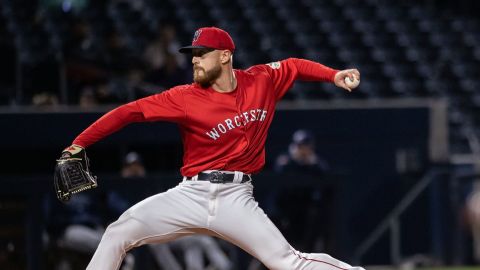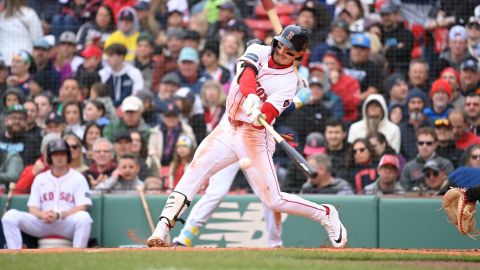The Marriott Copley lobby overflowed with people the weekend before this year’s Boston Marathon, but one person stood out in the crowd — a legend who forced the city to see that its most beloved ballclub was red, white and black.
The former Red Sox second baseman was surrounded by nearly 100 people that Saturday morning, and no one recognized him. Except one.
"Are you Pumpsie Green?" said a Marriott bellman.
"Yes," said Elijah Jerry "Pumpsie" Green.
"It's an honor to meet you," said the bellman as he was shaking Green’s hand.
Green smiled. They proceeded to chat about the ceremonial first pitch Green threw the night before (April 15) at Fenway Park in honor of Jackie Robinson Day, commemorating the 62nd anniversary of his major league debut with the Brooklyn Dodgers. The Red Sox flew Green in from his native California to be part of the ceremony.
Twelve years after Robinson’s pioneering achievement in 1947, Pumpsie Green became the first African-American to play for the Red Sox on July 21, 1959 at Chicago’s Comiskey Park. On Aug. 4, 1959, Green was introduced to Fenway Park and started at second base in the first game of a doubleheader against the Kansas City Athletics.
The bellman was one of the few Bostonians who understood the significance of this event. Aug. 4, 2009, is the 50th anniversary of Green’s Fenway Park debut. This is a unique opportunity to revisit an important day in Boston sports history.
***
It was the top of the first inning with a runner on first base. A grounder was hit to Red Sox third baseman Frank Malzone. Malzone scooped up the ball and whipped it to Green, who stepped on second for the force and threw to first for the double play.
The crowd cheered. It was the first time Red Sox fans had ever done that for a black player.
“I was almost on a cloud or in a trance or something,” Green recalled. “I couldn’t breathe. I was so hyped up.”
Green led off in the bottom of the first.
“Everybody in the park [was] screaming,” Green said. “They gave me a standing ovation.”
Umpire Eddie Rommel greeted Green at home plate.
“Hey, Pumpsie, welcome to the major leagues,” Rommel told the rookie.
Astonished at the welcome, Green gave himself a little advice: “I said, ‘Pumpsie, one thing you want to do is you want to hit the ball. You do not want to strike out and have to walk all the way back to the dugout after receiving a standing ovation.’”
Green got himself together, said a few prayers, and stepped into the batter’s box. K.C. right-hander John Tsitouris threw him a strike.
“I was lucky that I had seen this guy before,” Green said. “I had an idea of what he had and how he was going to pitch.”
Tsitouris threw Green a low curve.
“I swung and hit the hell out of the ball, off the Green Monster and in left-center field,” Green said.
He rounded the bases and slid into third with a triple.
“The crowd went crazy,” Green said. “They gave me another standing ovation. And I took a deep breath.”
Red Sox first baseman Pete Runnels was next and he hit a grounder to first base. Green booked it to home plate and scored. The Sox went up 1-0.
After Green scored, K.C. catcher Harry Chiti called for the ball. He said that Green did not tag home plate.
“I knew I ran across home plate,” Green said. “That’s where I’m supposed to go. I’ve done that a thousand times before.”
Rommel ended the suspense by ruling that Green had touched home plate. Green took another deep breath.
***
The next day, Green was invited to meet team owner Thomas A. Yawkey, whose record on race relations was (and remains) questionable. Not only was Yawkey the last owner to employ a black player, but in April 1945, he reluctantly offered a sham 90-minute tryout to Negro League standouts Jackie Robinson, Sam Jethroe and Marvin Williams.
Green headed up to Yawkey’s office. He walked in, looked around, saw the great names on the wall, shook Yawkey’s hand and sat down.
“Want a cup of coffee?” Yawkey asked.
“No thanks,” Green replied.
“Want something to drink?”
“No thanks.”
“I’d like to welcome you to the Boston organization,” Yawkey continued. “I’m pleased that you’re here … If you have any problems, you don’t necessarily have to go to the coach or somebody else. If you have any problems, give me a phone call. Any questions?”
“I can’t think of any,” Green said.
“Well, I wish you good luck,” Yawkey closed.
“Thank you, and I’ll see you later,” Green finished.
He headed for the clubhouse and got dressed to play ball.
***
Prior to meeting Yawkey, Green had only heard of him and knew very little about Boston. He once saw an image on TV that gave him a glimpse into Boston city life.
“I always remember this black man with a briefcase and he had 100, at least 100 white people, chasing him trying to catch him,” Green said. “I don’t know what for, but I knew one thing — he was running like hell.”
The image sticks with Green to this day. But just like the man on TV, he wasn’t immune from racism.
Green remembers a time during spring training in Scottsdale, Ariz., when the team went out to eat at a local restaurant. They sat down and were ready to order when a man came over to Green and said, “Hey, you can’t eat here.”
“What are you talking about?” Green responded.
“We don’t serve you people,” the man said.
Green stood up to leave and so did every ballplayer on the team.
“Hey, you guys don’t have to leave,” Green said. “I know you’re hungry.”
“No. We all go,” Green remembers one of them saying.
It was an important moment for Green.
“I didn’t know I couldn’t eat there,” he said. “They didn’t know either. But we were together.”
Former Red Sox pitcher Bill Monbouquette, who was close to Green, said, “That was a sour spot with me for them to speak like that to Pumpsie.”
Monbouquette, always known as “Monbo,” grew up in a racially mixed, working-class neighborhood in Medford, Mass. He did not tolerate any racial abuse toward blacks, especially to Pumpsie. Monbo once told then-Red Sox coach Del Baker to “shut up” after dropping the "n"-word at an opposing player while Green was in the dugout within earshot.
Monbo and Green were friends, but they rarely stayed in the same hotel. Green remembered staying “across the tracks” with a black family whenever the team traveled. After games, he would have to find a taxi to take him to the black part of town. Not all taxis were willing to go.
“That’s the way it was,” Green said. “Willie McCovey, Ernie Banks, Hank Aaron. We all did the same thing.”
Staying across the tracks was lonely for Green.
“The people I knew and played with every day were somewhere else,” he said. His best friends on the team — Malzone, Monbo, Runnels, Ted Lepcio — were all “uptown or downtown” in the hotels.
Despite the tracks, Green never lashed out.
“He never showed displeasure with anybody on our ballclub,” Malzone said. “He was a friend to everyone.”
Green particularly took to right-hander Earl Wilson, another black teammate.
“[Now] I was not alone,” Green said. “We protected each other. He had my back. I had his back, and we got along great.”
***
The Red Sox won Game 1 of the doubleheader 4-1. Green said he almost became a hero that night during Game 2. They were two runs behind with Runnels on second base and shortstop Don Buddin on third in the bottom of the eighth inning. Green hit a fly ball to deep center field, but it was snagged for the third out.
“I got an ovation for that, too,” Green said.
The Red Sox lost 8-6, but Green went 2-for-6 that night. He went on to play in 327 games with the Red Sox, hitting .246. In 1963, he was traded to the New York Mets, where he spent his last major league season.
Green never forgot his journey and said it was great to return to America’s most beloved ballpark 50 years later. Malzone, Monbo and Lepcio were present for Green’s honoring at Fenway Park.
“I hadn’t seen Pumpsie in many years,” Lepcio said. “It was like we had seen each other yesterday.”
When Green took the mound — before he threw the ceremonial first pitch — he received something that took him back to Aug. 4, 1959: a standing ovation. He stood on a major league field, and a packed Fenway house cheered for him.



